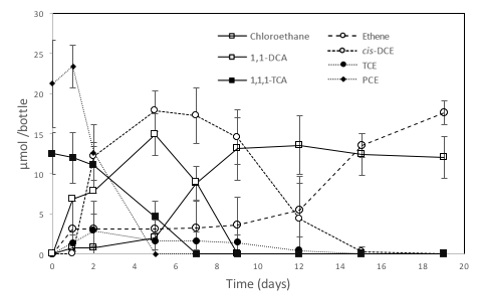
Detoxifying Pollutants through Biological Means
Opportunity
Chlorinated hydrocarbons are a class of toxic chemicals that can be found in industrial wastewater, soil and groundwater. They can pose an ecological risk, even at trace amounts, due to their ability to bio-accumulate. Although the use of chlorinated organic compounds has been reduced in recent years, they were previously widely used for pesticides and industrial processes. Because of this, some chlorinated organic pollutants still persist in the environment. Chlorinated organic compounds are also still used as components of industrial solvents and synthetic products. As such, they can be found in greater concentrations at higher levels in the food chain, as removal of these pollutants from the environment is difficult.
Several remediation techniques exist, including biological remediation, which is a process that uses micro-organisms, such as bacteria, to detoxify compounds from the environment. For instance, special bacterial isolates can consume toxic pollutants, such as chlorinated hydrocarbons and convert them into non-toxic materials through a process called dehalogenation. However, when employing biological remediation on site, it may be ineffective should the bacterial isolates used become unstable or become inhibited by co-contaminants that are present together with the pollutants. These co-contaminants are often halogenated compounds which the bacterial isolates cannot breakdown
Technology
NUS researchers have developed a defined mixed microbial culture to be used for biological remediation. It is capable of carrying out the complete dehalogenation of polychlorinated ethenes (PCE and TCE) to non-toxic ethene, as well as breaking down common soil and groundwater co-contaminants 1,1,1-trichloroethane and chloroform.
The defined mixed microbial culture can make use of lactate or pyruvate as sources of carbon for growth. It can be applied on site without other additives to help it grow and will thrive in microaerobic, anaerobic or anoxic environments. It can consume a broad range of chlorinated hydrocarbons through metabolic dehalogenation. This range includes:
• Tetrachloroethene;
• Trichloroethene;
• Dichlorethene isomers;
• Vinylchloride;
• 1,2-Dichloroethane;
• 1,1,1-Trichloroethane;
• 1,1,2-Trichloroethene; and
• Chloroform
In addition, the microbial culture can grow in the presence of one or more halogenated compounds (co-contaminants) to a maximum nominal concentration of 500µM.

Dechlorination of 1,1,1-trichloroethane (TCE) and tetrachlorethene (PCE) by the defined consortium of this technology. Data points are averaged from triplicates.


